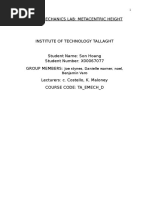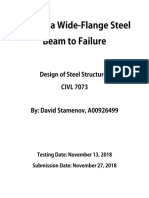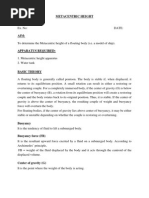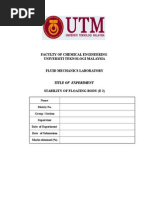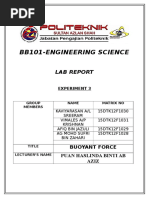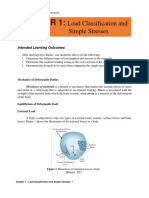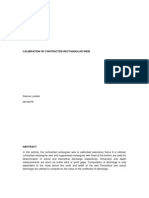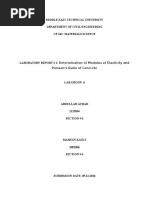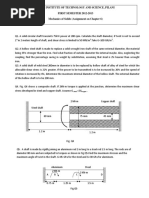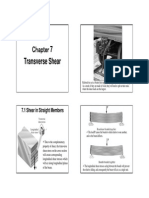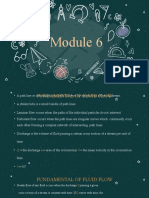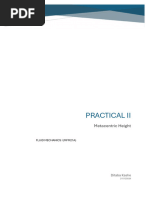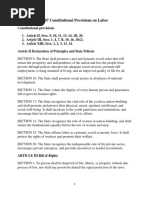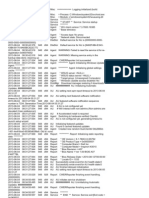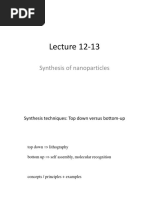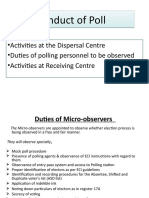Experiment 4 - Buoyancy (Done)
Experiment 4 - Buoyancy (Done)
Uploaded by
ptplCopyright:
Available Formats
Experiment 4 - Buoyancy (Done)
Experiment 4 - Buoyancy (Done)
Uploaded by
ptplCopyright
Available Formats
Share this document
Did you find this document useful?
Is this content inappropriate?
Copyright:
Available Formats
Experiment 4 - Buoyancy (Done)
Experiment 4 - Buoyancy (Done)
Uploaded by
ptplCopyright:
Available Formats
Experiment 4
Buoyancy
1.0 Objective
i) To obtain the value of metacentric height by the Buoyancy floating study
2.0 Introduction
When a body is immersed in a fluid partially or fully, an upward force which tends to
lift or float the body is subjected. This tendency of a body to immerse or float in fluid is called
buoyancy. There is a force exerted by the fluid on the floating body against the gravitational
force and it is known by buoyant force. In the third century B.C., Archimedes formulated the
well-known principle of floating body which is used to determine the magnitude of the
buoyant force. Base on Archimedes principle, it states that buoyant force is equal weight of
the liquid displaced by the body and which is an upward force that is opposite direction to
the force of gravity.
For metacentric height, is defined as the distance between the meta-center of a
floating body and the center of gravity of the body. For meta-center, it is defined as a point,
which a body is start to oscillating when this body is tilted by an angle. Meta-center can be
also defined as the point at which the line of action of the force of buoyancy will intersect the
normal axis of the body when the body is tilted with a small angle.
3.0 Methodology
3.1 Apparatus and Materials
i) Pontoon
ii) Adjustable weight
iii) Plumb weight
iv) String
v) Red container with water
3.2 Experimental Procedures
1. A center line that goes through the center hole of the pontoon to the 0
0
is
drawn with a white board marker pen.
2. The red container is filled with water. The pontoon is let to be float on water.
3. The adjustable weight is placed at the 2nd bottom row. (135mm away from
the base)
4. The plumb weight is ensured to point at the zero reading on the angular scale.
5. The adjustable weight is then moved in a stop across the width of the
pontoon, the corresponding angle of tilt is recorded each a step. Tip of the
scale for the angle reading and the sign convention for the reading should be
observed carefully to obtain accurate reading.
6. For the other three pontoons rows above, step 5 is repeated. The readings
are recorded into the table provided.
7. A graph of against x
1
is plotted. Gradient of all the cases are computed.
8. All the table provided are computed.
4.0 Result
Data analysis
Weight of pontoon (excluding adjustable weight) (Wp) = 1.280 kg
Adjustable weight () = 0.219 kg
Total weight, W = Wp + = 1.499 kg
Breadth of pontoon (D) = 0.220m
Length of Pontoon (L) = 0.305m
Second moment of area, I = LD
3
/12 = 2.706x10
-4
m
4
Pontoon displacement, V = W/ = 1.499x10
-3
m
3
Area of pontoon in water, A = LD = 0.0671 m
2
Depth of immersion, OC = V/A = 0.0223m
Height of centre to centre of buoyancy =OB=BC=OC/2 `` = 0.0112 m
= density of water = 1000 kg/m
3
Table 1: y
1
and OG of the experiment.
Height of adjustable
weight from base plate
(mm)
305 260 200 135 80
Center of gravity (OG)
(mm)
99 90 81 64 58
Table 2: Result of data obtained.
Height of
Adjustable
Weight, y
1
(mm)
Angle of List ()
For adjustable weight lateral displacement from sail center line , X
1
(mm)
-60 -50 -40 -30 -20 -10 0 10 20 30 40 50 60 70 80
135 -10 -9 -7 -5 -3 -2 0 2 4 5 7 9 10 11
200
-10 -8 -6 -4 -3 0 3 4 6 7
265
-7 -5 -3 0 2 3 4 6
315
-8 -5 -3 0 3
Table 3: Result from graph.
Height of
Adjustable
weight, y
1
(mm)
Height of G
above Water
Surface, OG
(mm)
dx
1
/d (mm/rad)
Meta-centric
Height, GM
(mm)
BM (mm)
135
64
9.73
1.42
52.8
200
81
51.30
7.49
69.8
265
90
53.02
7.75
78.8
315
99
36.21
5.29
87.8
dx
1
/d (mm/rad) = (Gradient of the graph)
-1
x 180
o
/
Meta-centric height, GM =
BM = BG + GM = OG - OB + GM
BM = BG = OG - OB
Graph 1: vs X
1
y = 1.1197x - 0.2042
y = 1.0806x - 1.0806
y = 1.5822x - 0.0685
y = 5.8894x - 0.0481
-80
-60
-40
-20
0
20
40
60
80
-15 -10 -5 0 5 10 15
A
n
g
l
e
x
1
(mm)
against X
1
Series1
Series2
Series3
Series4
Linear (Series1)
Linear (Series2)
Linear (Series3)
Linear (Series4)
Line equation for series 1 : y = 1.1197x 0.2042
Line equation for series 2 : y = 1.0806x 1.0806
Line equation for series 3 : y = 1.5822x 0.0685
Line equation for series 4 : 7 = 5.8894x 0.0481
Calculation
I = LD
3
/12
= [(0.305m) (0.220m)
3
] / 12
= 2.706x10
-4
m
4
V = W/
= 1.499kg / 1000 kg/m
3
= 1.499x10
-3
m
3
A = LD
= (0.305m) (0.220m)
= 0.0671 m
2
OC = V/A
= 1.499x10
-3
m
3
/ 0.0671 m
2
= 0.0223 m
OB =BC = OC/2 ``
= 0.0223 m / 2
= 0.0112 m
dx
1
/d = (Gradient of the graph)
-1
x 180
o
/
= (5.8894mm)
-1
x 180
o
/
= 9.73 mm/rad
GM =
= (0.219/1.499) kg x 9.73 mm/rad
= 1.42 mm
BM = BG = OG - OB
= 64 mm (0.0112x10
3
) mm
= 52.8 mm
5.0 Discussion
Based on the result and graph we get through this experiment, for the 315mm height
of the adjustable weight (y
1
), we get 5.29mm of the metacentric height (GM), and 87.8mm of
BM. This show that larger the value of height of the adjustable weight (y
1
), it yields larger
value of metacentric height (GM) and BM. Metacentric height (GM) is the measurement of
the initial static stability, and it is calculated by the distance between the centre of gravity of
the body and its metacenter. Higher value of metacentric height will implies greater stability
against overturning.
We get different result when compare to other groups result. When we are carrying
out the experiment, due to our parallax error, when we observed the reading of the plumb
weight. Besides, due to the environment which is windy in the laboratory, the plumb weight
is keep on shaking and cannot stop so we are not able to get the result accurately.
The state of equilibrium of a body that is fully or partially immersed in a liquid is
defined as floating. The theory of floating is concerned by determining the equilibrium
position of the body immersed in water and the condition of stability of the equilibrium. The
basic concept of Archimedes concept about the floating are the displacement of a body is
the weight of the liquid that displaced by the body and this weight is equal to the weight of
body. The vertically downward force which is the weight is balanced by the vertically upward
force which is the buoyant force. (Zhukovskii, 1952)
It is important to determine the stability of floatation for the ship building. Builder of
ship have to determine how far the ship can bear with the inclined force. It is an obvious
requirement that a floating body such as boat that does not topple when slightly disturbed.
(Aerospace, Mechanical & Mechatronic Engg. 2005). Ships still can be in equilibrium state
during the inclined movement as the volume immersed on the right hand side of the ship
increase while that part on left hand side is decrease. Therefore the centre of buoyancy
moves towards the right to its new position. This is the importance of determining the
stability of the floating body.
6.0 Conclusion
At last of the experiment, we had achieved our objective that the value of metacentric height
is obtained. Metacentric height for each height of adjustable weight (y
1
) 135mm, 200mm,
265mm, 315mm are 1.42mm, 7.49mm, 7.75mm, 5.29mm.
7.0 References
i) Aerospace, Mechanical & Mechatronic Engg. 2005 (http://www-
mdp.eng.cam.ac.uk/web/library/enginfo/aerothermal_dvd_only/aero/fprops/statics/node2
4.html)
ii) Zhukovskii, N. E. 1952, Floating of Body
(http://encyclopedia2.thefreedictionary.com/Floating+of+Bodies)
iii) DAS. M. M., 2008, FLUID MECHANIC AND TURBO MACHINE
(http://books.google.com.my/books?id=EY87AER8f-
4C&pg=PA63&dq=metacentric+buoyancy&hl=en&sa=X&ei=zksIU7HHAoTOiAez3YCAA
g&redir_esc=y#v=onepage&q=metacentric%20buoyancy&f=false)
iv) Bansal. R. K., 2005, A text Book of Fluid Mechanic and Hydraulic Machines
(http://books.google.com.my/books?id=nCnifcUdNp4C&pg=PA128&dq=metacentric+buo
yancy&hl=en&sa=X&ei=JVMIU_joHcubiQf104HoBQ&redir_esc=y#v=onepage&q=metac
entric%20buoyancy&f=false)
You might also like
- Fluids Mechanics Lab: Metacentric HeightDocument21 pagesFluids Mechanics Lab: Metacentric HeightAnonymous ZVC1U7Wc6s100% (2)
- Steel Lab ReportDocument14 pagesSteel Lab ReportDavid StamenovNo ratings yet
- Metacentric HeightDocument4 pagesMetacentric Heightkriap95No ratings yet
- Experiment 2 - Stability of Floating BodyDocument4 pagesExperiment 2 - Stability of Floating BodyKhairil Ikram0% (1)
- Lab #2: Hydrostatic Pressure: Section 5, Group 25Document15 pagesLab #2: Hydrostatic Pressure: Section 5, Group 25Jamilya SoneExolNo ratings yet
- Experiment 3: Metacentric HeightDocument12 pagesExperiment 3: Metacentric HeightYanskie JusainNo ratings yet
- Metacentric HeightDocument4 pagesMetacentric HeightVrushiket PatilNo ratings yet
- AbstractDocument9 pagesAbstractEssam Ahmed Abd MeguidNo ratings yet
- Cable and ArchesDocument15 pagesCable and Archess k sharmaNo ratings yet
- Stress and StrainDocument7 pagesStress and StrainAnonymous mXicTi8hBNo ratings yet
- Advance Engineering Surveying: Lecture 6: Transition and Combined CurveDocument16 pagesAdvance Engineering Surveying: Lecture 6: Transition and Combined CurveMirza TalhaNo ratings yet
- Falling Sphere ExperimentDocument4 pagesFalling Sphere ExperimentAus AlisterNo ratings yet
- Essentials of Hydraulics - DrSolomon Chapters 1 - 3Document135 pagesEssentials of Hydraulics - DrSolomon Chapters 1 - 3Jôssŷ FkrNo ratings yet
- Centre of Pressure Level 1Document12 pagesCentre of Pressure Level 1Mohd Azeem RizalNo ratings yet
- Mechanics of Fluids Problem Set On Total Hydrostatic Force, Dams Ad Buoyancy Identification: Due Date: July 7, 2020Document3 pagesMechanics of Fluids Problem Set On Total Hydrostatic Force, Dams Ad Buoyancy Identification: Due Date: July 7, 2020Mpgmhl C John LyndonNo ratings yet
- Experiment8 JOSHUA TO EHDocument11 pagesExperiment8 JOSHUA TO EHPauSomerhalderNo ratings yet
- Lab Report Metacentric Height Latest PDFDocument9 pagesLab Report Metacentric Height Latest PDFSharip MaxwellNo ratings yet
- Principles of Hydrostatics Lesson2Document14 pagesPrinciples of Hydrostatics Lesson2Tomori Nao100% (1)
- MODULE 2 PART 1 (Hydraulics)Document9 pagesMODULE 2 PART 1 (Hydraulics)Light HouseNo ratings yet
- Newton's Law ExperimentDocument22 pagesNewton's Law ExperimentCharlesNo ratings yet
- Fluid Mechanics Sessional CE 262Document28 pagesFluid Mechanics Sessional CE 262মোঃমেহেদী হাসান শরীফNo ratings yet
- PHY 101 2019-2020 Fluid MechanicsDocument26 pagesPHY 101 2019-2020 Fluid MechanicsDave LarryNo ratings yet
- Chapter-1: Introduction To Dynamics Mechanics As The Origin of DynamicsDocument92 pagesChapter-1: Introduction To Dynamics Mechanics As The Origin of DynamicsRoutine Of Nepal BandaNo ratings yet
- Soil Mechanics Chapter 4Document20 pagesSoil Mechanics Chapter 4Kc Kirsten Kimberly MalbunNo ratings yet
- Volumes by Sections Using Prismoidal Formulas PDFDocument4 pagesVolumes by Sections Using Prismoidal Formulas PDFGusty Deni SetiawanNo ratings yet
- Flow Through An OrificeDocument6 pagesFlow Through An Orificehozipek559950% (2)
- Hydrostatic Pressure LabDocument8 pagesHydrostatic Pressure Labapi-307743354No ratings yet
- Science Enginering Lab Report Experiment 3 Buoyant Force PDFDocument9 pagesScience Enginering Lab Report Experiment 3 Buoyant Force PDFMuhammad Haziq IzzudinNo ratings yet
- Metacentric HeightDocument5 pagesMetacentric HeightKHAIRUNISANo ratings yet
- Scenario 1Document31 pagesScenario 1حنان عليNo ratings yet
- ENSC 3233 HW #1 Solution PDFDocument10 pagesENSC 3233 HW #1 Solution PDFheem bashaNo ratings yet
- Combinepdf 1Document111 pagesCombinepdf 1Jeremy MacalaladNo ratings yet
- Manual Laboratory Experiment No. 4 BangguiyacDocument11 pagesManual Laboratory Experiment No. 4 BangguiyacJohn Paul LiwaliwNo ratings yet
- Calibration of Contracted Rectangular WeirDocument9 pagesCalibration of Contracted Rectangular WeirDianne Ilao LondobNo ratings yet
- Topic 4 Buoyancy, Stability of Floating BodiesDocument37 pagesTopic 4 Buoyancy, Stability of Floating BodiesMerwin Andrew UyNo ratings yet
- Lab ReportDocument16 pagesLab Reportabe97No ratings yet
- Torsion TestDocument7 pagesTorsion Testilya danisyahNo ratings yet
- Stability Experiment 2 UpdateDocument7 pagesStability Experiment 2 UpdateApostrophe Fareez ImprezzaNo ratings yet
- Mof-Chapter-2 - 20 PDFDocument45 pagesMof-Chapter-2 - 20 PDFMOHAMMED NOUMAN A Dept of Civil EngineeringNo ratings yet
- Lab Manual 2.3 - LEVEL 0 - Determination of Metacentric HeightDocument6 pagesLab Manual 2.3 - LEVEL 0 - Determination of Metacentric HeightMuhamad IzzanNo ratings yet
- Quiz 3Document2 pagesQuiz 3acurvz2005No ratings yet
- Basic Fluid Statics Solved ProblemsDocument15 pagesBasic Fluid Statics Solved ProblemsSamuel Dela CruzNo ratings yet
- Assignment 6Document3 pagesAssignment 6radhikaNo ratings yet
- Impact of JetDocument8 pagesImpact of Jetpravishek maniNo ratings yet
- Experiment - Three Hinge ArchDocument4 pagesExperiment - Three Hinge ArchAmeera AlexandraNo ratings yet
- Solution Manual For Mechanics of MateriaDocument54 pagesSolution Manual For Mechanics of MateriaJericho CunananNo ratings yet
- Practice Problem No. 1 Hydraulics Fundamentals of Fluid FlowDocument2 pagesPractice Problem No. 1 Hydraulics Fundamentals of Fluid FlowCharlamagne MirandaNo ratings yet
- Project For Module 2 - Problem Set With SolutionDocument22 pagesProject For Module 2 - Problem Set With SolutionNara JoNo ratings yet
- Differential Inverted ManometerDocument7 pagesDifferential Inverted ManometerArmenion Mark Allen100% (1)
- Mechanics of Material - Transverse ShearDocument13 pagesMechanics of Material - Transverse ShearHowl SolomonNo ratings yet
- Capillary Elevation in Capillary TubesDocument2 pagesCapillary Elevation in Capillary TubesJeffries ThabangNo ratings yet
- Module6 Fluid MechanicsDocument23 pagesModule6 Fluid MechanicsPaolo Martinez PHNo ratings yet
- Energy Losses in Bends - : Experiment No. - 09Document7 pagesEnergy Losses in Bends - : Experiment No. - 09John Michael Menoza ZapantaNo ratings yet
- BuoyancyDocument24 pagesBuoyancyTauseefNo ratings yet
- Fluid Prac 2 (April 2024)Document14 pagesFluid Prac 2 (April 2024)ditabaNo ratings yet
- Stability of Floating Bodies: Hydraulic Lab Practical - 2Document7 pagesStability of Floating Bodies: Hydraulic Lab Practical - 2tarumNo ratings yet
- Lab 2 Hyrdro 1Document8 pagesLab 2 Hyrdro 1Mark Angelo SalazarNo ratings yet
- Experiment 2 PDFDocument25 pagesExperiment 2 PDFVinoth Kumar Vins0% (1)
- 2134 Lab NishantDocument9 pages2134 Lab NishantNishant JalgaonkarNo ratings yet
- MoF - Exp 8Document11 pagesMoF - Exp 8Mohd SaufiNo ratings yet
- Hail Holy Queen - CoroDocument4 pagesHail Holy Queen - CoroCarlo ArdizzoniNo ratings yet
- Constitutional Provisions On LaborDocument3 pagesConstitutional Provisions On LaborRio AborkaNo ratings yet
- Labyrinths Mazes and The Spaces Inbetwee PDFDocument6 pagesLabyrinths Mazes and The Spaces Inbetwee PDFManuel Jesús Píriz GilNo ratings yet
- LC Medical 2Document17 pagesLC Medical 2Kharisma Wildan FuadiNo ratings yet
- San Isidro Deed of ConveyanceDocument2 pagesSan Isidro Deed of ConveyanceAnonymous SAJv5NxQNo ratings yet
- Critical Response Scoring RubricDocument1 pageCritical Response Scoring Rubricapi-393009073No ratings yet
- Kloppers Critical 2003 PDFDocument363 pagesKloppers Critical 2003 PDF조기현No ratings yet
- Essentials of Personal Growth PDFDocument25 pagesEssentials of Personal Growth PDFanastias20008766No ratings yet
- 1333 11 PB PDFDocument149 pages1333 11 PB PDFChandra Nara OchanNo ratings yet
- Pascual vs. Hon. Provincial Board of Nueva Ecija (106 Phil 466), States ThatDocument1 pagePascual vs. Hon. Provincial Board of Nueva Ecija (106 Phil 466), States ThatMarilou AgustinNo ratings yet
- UpdatesDocument197 pagesUpdatesthahcitdNo ratings yet
- Lecture 13q 2Document46 pagesLecture 13q 2Aahil AleemNo ratings yet
- For Micro Observer WB2021Document58 pagesFor Micro Observer WB2021Novojit ChakrabortyNo ratings yet
- The Pursuit of Happyness: Presented By: Abdul Hannan Asif Alam Khushal Sharma Mehzar AbbasDocument18 pagesThe Pursuit of Happyness: Presented By: Abdul Hannan Asif Alam Khushal Sharma Mehzar AbbasCovering KashmirNo ratings yet
- LIT 01 Short StoriesDocument10 pagesLIT 01 Short StoriesJames Christian SacopasoNo ratings yet
- Teaching The Writing Process - (Literacy Strategy Guide)Document8 pagesTeaching The Writing Process - (Literacy Strategy Guide)Princejoy ManzanoNo ratings yet
- Jungles & SavannasDocument80 pagesJungles & SavannasJessica100% (1)
- Sem.5, AdventureDocument7 pagesSem.5, AdventureMasha Yashchuk100% (1)
- Assignment 2: Formulating Research: Unit 1 - Basic Course in Biomedical Research: Cycle 2 (Mar-Jun 2020)Document6 pagesAssignment 2: Formulating Research: Unit 1 - Basic Course in Biomedical Research: Cycle 2 (Mar-Jun 2020)stNo ratings yet
- Aftab Currency Exchange Internship ReportDocument30 pagesAftab Currency Exchange Internship Reportbbaahmad8950% (2)
- Pale Case Digests Canons 4 8Document8 pagesPale Case Digests Canons 4 8NLainie OmarNo ratings yet
- ISFO Sample Paper Math 2Document4 pagesISFO Sample Paper Math 2RITUL JANGIRNo ratings yet
- Group Members: Bettega Davide Birleanu Raluca Costiuc Alexandra D'Alessandro Antonio Rusu RalucaDocument19 pagesGroup Members: Bettega Davide Birleanu Raluca Costiuc Alexandra D'Alessandro Antonio Rusu Ralucaalexandracostiucale0% (1)
- Self ConceptDocument6 pagesSelf ConceptCherryNo ratings yet
- The Godfather 4Document5 pagesThe Godfather 4Lucile LOUNo ratings yet
- Q4 Structural EngineerDocument4 pagesQ4 Structural Engineerpaul machariaNo ratings yet
- Open Enlightenment EbookDocument56 pagesOpen Enlightenment Ebooklodovico65100% (2)
- Advanced Phrasal VerbsDocument2 pagesAdvanced Phrasal VerbsLaura Valero LopezNo ratings yet
- Agree Strongly Agree Strongly Agree Strongly Disagree Neutral Neutral Strongly Agree Strongly Agree Strongly Agree NeutralDocument3 pagesAgree Strongly Agree Strongly Agree Strongly Disagree Neutral Neutral Strongly Agree Strongly Agree Strongly Agree NeutralFernanda RoldanNo ratings yet
- 2601 2604 and 2501 MSExchange ADAccessDocument4 pages2601 2604 and 2501 MSExchange ADAccessCompletAnonimNo ratings yet
